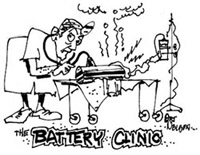|
|
 |
|

|
 |
A short develops in a Ni-Cd when conductive particulates bridge the separator or the separator itself deteriorates to
the point where it allows the positive and negative plates to touch. Rarely does the short occur all at once but rather building
up a very small conductance path termed "soft shorts". In a charged cell the energy in the cell will blow away any
short as it tries to develop. You've heard about "zapping" cells. The cell actually zaps itself before the short
can develop. Only in cases of severe overcharge at high rates when the cell heats up significantly, can the separator melt
down to the point where the plates contact each other (hard short). In this case the energy in the cell then dumps and we
have what is referred to as a hot steamer, the electrolyte boils, nylon in the separator melts down and is forced by the steam
through the vent. On some occasions the vent is clogged by the molten nylon separator and becomes inoperative causing the
cell to rapidly disassemble. So under normal circumstances a cell maintained at some state of charge is much less likely to
short than a cell that is completely discharged. It should be noted however that the self discharge increases rapidly in cells
where there is a short building (high resistance -soft short) due to separator deterioration and/or cadmium migration. One
other shorting mechanism is a manufacturing defect where the positive or negative collector tab bridges the opposite plate.
These usually fall out before the cells are shipped or assembled into batteries. cls 12/96
|
 |
|
|
 |
|
|
 |
|
|
|
Hangtimes Hobbies NoBS Batteries
|
|
|
 |

